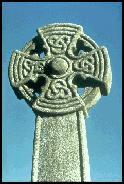
The Standing Stones of Cornwall
An Savow Meyn A Kernow
Web: www.historic-cornwall.org.uk
Don't stand around
There are many standing stones, or longstones, widely distributed throughout Cornwall. More commonly known by the Cornish term "menhir"(men- stone; hir- long) there are nearly ninety in the Land's End peninsula alone.
These tall granite blocks often stand alone and the sheer logistics of moving them to their location and erecting them pay tribute to the engineers of Bronze Age times. Some were doubtless used for religious rites whilst others stand as huge gravestones, marking the burial places of ancient folk.
Many of circles and stones have given rise to both charming and gruesome legends.
The Merry Maiden Stones
 The Merry Maidens of Boleigh, Near Land's End, a group of nineteen stones in a large circle were most probably originally used for some long forgotten religious rite but folklore tells a different tale. ... Once, nineteen pretty maidens on their way to Sunday vespers were distracted by the playing of The Pipers, now seen as two tall standing stones a quarter mile distant, and strayed into the field, full of high spirits to laugh and dance to their music. A mighty thunderbolt transfixed both pipers and maidens to the spot where they now forever stand, turned to stone for the sin of dancing on The Sabbath Day.
The Merry Maidens of Boleigh, Near Land's End, a group of nineteen stones in a large circle were most probably originally used for some long forgotten religious rite but folklore tells a different tale. ... Once, nineteen pretty maidens on their way to Sunday vespers were distracted by the playing of The Pipers, now seen as two tall standing stones a quarter mile distant, and strayed into the field, full of high spirits to laugh and dance to their music. A mighty thunderbolt transfixed both pipers and maidens to the spot where they now forever stand, turned to stone for the sin of dancing on The Sabbath Day.
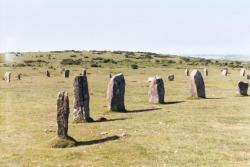 Not far from Liskeard stand another group of stones that also serve as a stern warning against fun and games on the Sabbath Day. The Hurlers are the remnants of three stone circles whose original purpose was probably Druidical but is now lost in the mists of time. Many centuries ago the game of hurling was popular in Cornwall, a sort of primitive rugby game with goals several miles apart. The folk of St. Cleer loved the game and would play it whenever the opportunity arose, even on Sundays. This was their downfall. Despite the disapproving lectures of the local saint and priest, St. Cleer himself, they continued to play for the honour of their village and a game was set for a Sunday against the villagers of nearby St. Ive. St. Cleer went in search of his errant flock and found them in the midst of a hotly contested match. He ordered them to cease their game and respect the Sabbath but they only told him not to be a spoilsport and to return to his prayers.
Not far from Liskeard stand another group of stones that also serve as a stern warning against fun and games on the Sabbath Day. The Hurlers are the remnants of three stone circles whose original purpose was probably Druidical but is now lost in the mists of time. Many centuries ago the game of hurling was popular in Cornwall, a sort of primitive rugby game with goals several miles apart. The folk of St. Cleer loved the game and would play it whenever the opportunity arose, even on Sundays. This was their downfall. Despite the disapproving lectures of the local saint and priest, St. Cleer himself, they continued to play for the honour of their village and a game was set for a Sunday against the villagers of nearby St. Ive. St. Cleer went in search of his errant flock and found them in the midst of a hotly contested match. He ordered them to cease their game and respect the Sabbath but they only told him not to be a spoilsport and to return to his prayers.
Angered, St. Cleer raised his staff and pronounced in solemn tones that since they preferred their game to the worship of God they must stay there forever more as a lesson to others. He lowered his staff and the players were instantly turned to stone, hurling forever on the wastes of Craddock Moor. There is also a curious optical illusion connected with the Hurlers. Try counting them with the naked eye, invariably you will reach a different total every time?
The Quoits
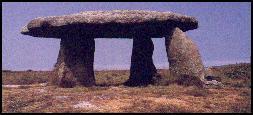 Cornwall possesses many megalithic chamber tombs, the last resting place of warriors from some four thousand years ago. These are probably the most fascinating of all Cornwall's many antiquities. Known variously as cairns, dolmens, quoits, tumuli and cromlech there are a particularly large number of them in and around the Land's End peninsula and on the Isles of Scilly, but among the most impressive are Trethevy Quoit, near Liskeard and Lanyon Quoit, situated between Penzance and Land's End. King Arthur himself is said to have used Lanyon Quoit as a dining table on the eve of his last battle. These megalithic tombs were burial chambers not for one but many, some accommodating twenty or more corpses. They were, in effect, stone charnel houses constructed of huge stone slabs which were then originally covered in earth to become burial mounds.
Cornwall possesses many megalithic chamber tombs, the last resting place of warriors from some four thousand years ago. These are probably the most fascinating of all Cornwall's many antiquities. Known variously as cairns, dolmens, quoits, tumuli and cromlech there are a particularly large number of them in and around the Land's End peninsula and on the Isles of Scilly, but among the most impressive are Trethevy Quoit, near Liskeard and Lanyon Quoit, situated between Penzance and Land's End. King Arthur himself is said to have used Lanyon Quoit as a dining table on the eve of his last battle. These megalithic tombs were burial chambers not for one but many, some accommodating twenty or more corpses. They were, in effect, stone charnel houses constructed of huge stone slabs which were then originally covered in earth to become burial mounds.
Nature and local farmers have in many cases conspired to remove the mounds, to reveal these extraordinary monuments to Bronze Age folk. Throughout Cornwall, fields are dotted with tumuli, or burial mounds. Many have been destroyed over the centuries but hundreds still remain, merely grassy mounds to the naked eye but beneath them lie stone capped burial chambers, some containing no doubt ancient artefacts and ornate cremation urns from thousands of years ago.
Men - An - Tol
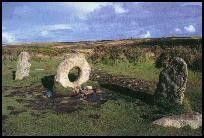 To the north-west of Madron on the Land's End peninsula stands the extraordinary holed stone "Men-An-Tol", locally referred to as the Crick Stone for its supposed curative powers for a crick in the back or any other part of the anatomy. Flanked by two upright stones it may once have been a porthole stone allowing access to some long lost burial vault but has long been regarded as a fertility symbol. Legend suggested that a crick in the body could be cured by crawling nine times through the hole in the centre of the stone, going against the course of the sun. For centuries children suffering from rickets were brought here to be passed naked through the Men-An-Tol, then drawn three times on the grass against the sun. A more modern theory suggests that the stones were once used for astronomy, suggesting that the upright stones on either side may have been sighting stones for observing the sunrise and sunset.
To the north-west of Madron on the Land's End peninsula stands the extraordinary holed stone "Men-An-Tol", locally referred to as the Crick Stone for its supposed curative powers for a crick in the back or any other part of the anatomy. Flanked by two upright stones it may once have been a porthole stone allowing access to some long lost burial vault but has long been regarded as a fertility symbol. Legend suggested that a crick in the body could be cured by crawling nine times through the hole in the centre of the stone, going against the course of the sun. For centuries children suffering from rickets were brought here to be passed naked through the Men-An-Tol, then drawn three times on the grass against the sun. A more modern theory suggests that the stones were once used for astronomy, suggesting that the upright stones on either side may have been sighting stones for observing the sunrise and sunset.
Men Scryfa
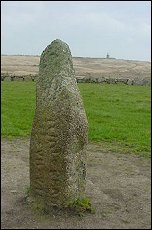 One of the most impressive Menhirs is Men Scryfa, a short walk from Men - An - Tol. The name means "inscribed stone" and is thought to be the burial place of a King slain at the battle of Gendhal Moor. Inscribed are the latin words "Rialobrani Cunovali Fili" - Rialobran, son of Cunoval. Legend says he was as tall as his grave stone - nine feet - and lays buried beneath it with his weapons and treasures.
One of the most impressive Menhirs is Men Scryfa, a short walk from Men - An - Tol. The name means "inscribed stone" and is thought to be the burial place of a King slain at the battle of Gendhal Moor. Inscribed are the latin words "Rialobrani Cunovali Fili" - Rialobran, son of Cunoval. Legend says he was as tall as his grave stone - nine feet - and lays buried beneath it with his weapons and treasures.
The Cheesewring
 Legend tells us that the Cheesewring, near Minions, was formed in the time of Saints and Giants. The giants reckoned the Saints were setting up too many preaching crosses, taking too many wells as holy and claiming too many tithes from the hard won harvest of the land and sea and enjoying too much attention. The Giants met on Bodmin Moor to decide what to do. The Giants were annoyed because they had inhabited Cornwall far longer than the Saints. The Giants elected Uther as their leader as he had the best brain and broadest shoulders. St. Tue, a rather diminutive saint, had just claimed a well on the Moor. He heard the giants arguing over how to rid themselves of these saints without upsetting the local folk. He decided to challenge Uther to a trial of strength, he challenged them to a rock throwing contest!
Legend tells us that the Cheesewring, near Minions, was formed in the time of Saints and Giants. The giants reckoned the Saints were setting up too many preaching crosses, taking too many wells as holy and claiming too many tithes from the hard won harvest of the land and sea and enjoying too much attention. The Giants met on Bodmin Moor to decide what to do. The Giants were annoyed because they had inhabited Cornwall far longer than the Saints. The Giants elected Uther as their leader as he had the best brain and broadest shoulders. St. Tue, a rather diminutive saint, had just claimed a well on the Moor. He heard the giants arguing over how to rid themselves of these saints without upsetting the local folk. He decided to challenge Uther to a trial of strength, he challenged them to a rock throwing contest!
St. Tue vowed that if the Giants won that all the saints would leave these shores forever, but if he won that the giants must mend their errant ways, and henceforth follow the sign of the cross. Uther was a champion rock-hurler, he could toss heavy rocks with great strength and accuracy, his speciality was to balance bigger ones on smaller, maintaining perfect balance. The Giants couldn't believe their luck they were bound to win against one so small and weak. They gathered twelve flattish roundish rocks of varying sizes. St. Tue insisted it was Uther's turn first seeing as he took up the challenge. So picking up the smallest rock,he pitched it a hundred feet or so in the direction of Stowe's Hill, where it came to rest near the southern summit. St. Tue cast his eyes to heaven for divine assistance,and suddenly the heavy rock in his hand felt like a feather it flew towards the first rock and capped it. So the competition went on. St. Tue managing to throw the heavy rocks one on top of the other on to Uther's, the giants couldn't believe their eyes. Naturally the task got harder as the tower of rocks grew bigger, St. Tue had the last throw the Giants were amazed when his rock hit the target and balanced perfectly.
However the contest was not over yet, as the unsporting Giants argued that it was customary to have one more for luck, and that a 13th rock would surely clinch the deal. Uther struggled to lift the final rock, it took all his strength, but he let fly with all his might. The rock fell short, stood on end and rolled back down the hill to land at St. Tue's feet, now it his turn! St. Tue prayed silently as he tried to lift the rock. Then an angel, only visible to him, clasped the stone and bore it away to crown the top heavy Cheesewring for mortals to marvel at for evermore. Uther promised to abandon his sinful ways, most of the others followed their leaders example although some went off into the hills warning of vengeance.
Ancient Sites in Cornwall Bodmin Moor Cornish Folklore & Legends English Heritage in Cornwall
 The Merry Maidens of Boleigh, Near Land's End, a group of nineteen stones in a large circle were most probably originally used for some long forgotten religious rite but folklore tells a different tale. ... Once, nineteen pretty maidens on their way to Sunday vespers were distracted by the playing of The Pipers, now seen as two tall standing stones a quarter mile distant, and strayed into the field, full of high spirits to laugh and dance to their music. A mighty thunderbolt transfixed both pipers and maidens to the spot where they now forever stand, turned to stone for the sin of dancing on The Sabbath Day.
The Merry Maidens of Boleigh, Near Land's End, a group of nineteen stones in a large circle were most probably originally used for some long forgotten religious rite but folklore tells a different tale. ... Once, nineteen pretty maidens on their way to Sunday vespers were distracted by the playing of The Pipers, now seen as two tall standing stones a quarter mile distant, and strayed into the field, full of high spirits to laugh and dance to their music. A mighty thunderbolt transfixed both pipers and maidens to the spot where they now forever stand, turned to stone for the sin of dancing on The Sabbath Day.
 Not far from
Not far from  Cornwall possesses many megalithic chamber tombs, the last resting place of warriors from some four thousand years ago. These are probably the most fascinating of all Cornwall's many antiquities. Known variously as cairns, dolmens, quoits, tumuli and cromlech there are a particularly large number of them in and around the Land's End peninsula and on the
Cornwall possesses many megalithic chamber tombs, the last resting place of warriors from some four thousand years ago. These are probably the most fascinating of all Cornwall's many antiquities. Known variously as cairns, dolmens, quoits, tumuli and cromlech there are a particularly large number of them in and around the Land's End peninsula and on the  To the north-west of Madron on the
To the north-west of Madron on the  One of the most impressive Menhirs is Men Scryfa, a short walk from Men - An - Tol. The name means "inscribed stone" and is thought to be the burial place of a King slain at the battle of Gendhal Moor. Inscribed are the latin words "Rialobrani Cunovali Fili" - Rialobran, son of Cunoval. Legend says he was as tall as his grave stone - nine feet - and lays buried beneath it with his weapons and treasures.
One of the most impressive Menhirs is Men Scryfa, a short walk from Men - An - Tol. The name means "inscribed stone" and is thought to be the burial place of a King slain at the battle of Gendhal Moor. Inscribed are the latin words "Rialobrani Cunovali Fili" - Rialobran, son of Cunoval. Legend says he was as tall as his grave stone - nine feet - and lays buried beneath it with his weapons and treasures. Legend tells us that the
Legend tells us that the 
